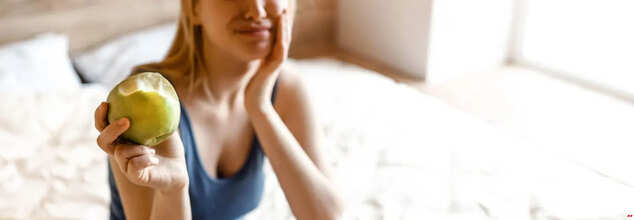- Health Conditions A-Z
- Health & Wellness
- Nutrition
- Fitness
- Health News
- Ayurveda
- Videos
- Medicine A-Z
- Parenting
- Web Stories

Credit: Canva
Think Beyond Cloves: 9 Surprising Ayurvedic Remedies For Tooth Ache
Toothaches can be incredibly distressing, but traditional remedies offer natural ways to relieve pain and promote oral hygiene. Over the centuries, many herbs and natural ingredients have proven their effectiveness in soothing dental issues.
Cloves have been a trusted remedy for tooth pain for generations. Rich in eugenol, an oil with powerful healing and soothing properties, cloves help calm the nerves inside the tooth. Chewing a few cloves near the affected tooth allows the natural oil to seep into the area, providing relief. Alternatively, a mixture of clove oil and a few drops of olive oil can be applied directly to the aching tooth using a cotton swab. Afterward, rinsing the mouth with warm saltwater helps eliminate bacteria and clear any residual oil.
In rural parts of India, herbal sticks like Neem and Babool continue to be widely used for oral care. These sticks are known for their antibacterial properties, helping fight tooth decay and plaque. The Miswak stick, in particular, offers strong anti-microbial benefits. A fresh, soft stem, free of leaves and bark, can be chewed gently to clean the teeth naturally. For those seeking a more convenient option, herbal toothpastes fortified with extracts of Babool and Miswak, such as Dabur Babool and Dabur Meswak, provide similar benefits and leave the mouth feeling clean and fresh.
Amla powder, derived from the Indian gooseberry, is another powerful natural remedy. Rich in antioxidants, Amla helps strengthen connective tissues, supporting overall tooth health. Consuming a teaspoon of Amla powder daily can offer long-term benefits for stronger, healthier teeth and gums.
Another traditional remedy is asafoetida, or hing, a resin obtained from the Ferula plant. Beyond its culinary use, asafoetida possesses anti-inflammatory properties that can ease tooth pain. It can be applied raw directly onto the affected area or mixed with lemon juice to create a paste. The lemon juice enhances the antibacterial action, providing quick relief.
Wheatgrass is also known for its ability to relieve dental pain. It acts as a natural detoxifier and can be used as a mouthwash to combat bacteria. Chewing on wheatgrass strands or gargling with wheatgrass juice or diluted wheatgrass powder can help soothe the affected area and promote oral hygiene.
Turmeric powder, or haldi, celebrated for its antibacterial and healing qualities, can prevent dental infections. A paste made from finely ground turmeric and mustard oil can be applied to the affected tooth before bedtime for relief.
Garlic, too, has earned its place in traditional medicine. It is known to offer immediate relief from tooth pain when chewed raw. Alternatively, a paste made from garlic and salt can be applied to the sore tooth to harness its natural antibiotic properties.
Nutmeg, though less popular, is equally effective. It contains eugenol, like cloves, and offers anti-inflammatory benefits. A paste made from nutmeg powder and mustard oil can help soothe dental discomfort.
Finally, Triphala Churna, a combination of three fruits, offers a simple solution for maintaining oral health. Gargling with a warm mixture of Triphala powder and water regularly can strengthen teeth and keep decay and pain at bay.

Credit: Canva
Tulsi: How This Sacred Herb Can Detox, Heal, and Boost Immunity Naturally
Tulsi is worshipped in Hinduism as it is believed to be an incarnation of the goddess Laxmi. Thus, it is not uncommon to find this herbal plant in Indian households. However, recently, the Uttar Pradesh Forest Department planted thousands of Tulsi plants around the Taj Mahal. But do you know the reason behind them?
Here's Why Tulsi Is Planted Around Indian Households
Since ancient times, basil has been called the "Queen of Herbs." In India, almost every household used to have a basil plant in their courtyard. It is because they release oxygen for up to 20 hours a day and protect the ozone layer within just four hours. Additionally, basil can purify the air within a 100-square-foot radius. This is the same reason why these herbal plants were put in the Taj Mahal's vicinity.
Besides purifying the air, tulsi is known for its medicinal properties—it can help counteract the side effects of paracetamol and anti-TB medicines. It also reduces DNA damage, inhibits tumour growth, and is beneficial for conditions like asthma and bronchitis.
Rekevance Of Tulsi In Ayurveda
Tulsi is known for balancing the body's doshas—Vata, Pitta, and Kapha—tulsi is celebrated for promoting holistic well-being. It acts as a natural adaptogen, helping the body manage stress, and is valued for its antimicrobial, anti-inflammatory, and antioxidant effects. Ayurveda recommends tulsi for boosting immunity, enhancing respiratory health, and supporting digestive function. Regular consumption of tulsi tea or leaves is believed to purify the blood and strengthen the heart. Its spiritual significance further elevates its role in promoting physical and mental harmony.
What Happens When You Consume Tulsi First Thing In Morning?
When consumed first thing in the morning, tulsi leaves can provide several health advantages.
- Immunity Booster: Tulsi is rich in antioxidants such as vitamin C and eugenol. These compounds help fight free radicals and support the immune system. Daily intake may help the body resist infections and improve overall resilience.
- Detoxification Powerhouse: Tulsi’s natural diuretic qualities help eliminate toxins and excess water. This cleansing effect can support kidney function, purify the blood, and result in clearer skin.
- Digestive Aid: Eating tulsi leaves on an empty stomach may stimulate the production of digestive enzymes. This boosts nutrient absorption and eases digestion, while its anti-inflammatory traits soothe the gut lining and reduce bloating.
- Stress Relief And Mood Enhancement: Tulsi is known for its adaptogenic properties, which help the body manage stress by regulating cortisol levels. This may lead to improved mood, reduced anxiety, and a greater sense of calm.
- Respiratory Support: Used traditionally for coughs, colds, and asthma, tulsi’s antimicrobial and anti-inflammatory effects support respiratory health and relieve airway discomfort.
- Blood Sugar Regulation: Some studies indicate that tulsi can help manage blood sugar by enhancing insulin sensitivity and glucose metabolism, potentially aiding those with diabetes or prediabetes.
ALSO READ: Vague Symptoms Of This Deadly Disease Caused Woman To Mistake It For Menopause

Credits: Canva
Beyond The Placebo Effect: What Ayurvedic Remedies Have Proven Scientific Backing?
When doctors give you a tiny pill, saying it will provide instant relief. You swallow it, and in a matter of minutes, the pain starts to fade. What if that pill was just sugar? Welcome to the intriguing realm of the placebo effect—where faith can create physical healing. But what if a medical system—such as Ayurveda—is routinely criticized as being placebo-based? Can traditional remedies hold their own against modern science?
In a wellness-driven world, more people are turning to alternative healing systems like Ayurveda, seeking natural remedies that promise holistic health without side effects but one lingering question remains—do these remedies truly work, or are they merely benefiting from the placebo effect?
To answer this, we spoke to Dr. Rohit Sane, an Ayurvedic physician—a healthcare organization committed to merging ancient Ayurvedic wisdom with modern medical scrutiny. Their studies, particularly in cardiovascular health, are not just challenging the placebo narrative—they’re redefining how we look at holistic healing.
What is a Placebo Effect?
Placebo, by its nature, is treatment with zero therapeutic effect. Yet patients feel improved after ingestion of placebos because they assume that they have received actual medication. The body responds to anticipation—releases endorphins, alters perception, and even modifies pain. The effect is so powerful that today's pharmaceutical company drug tests incorporate a control or placebo arm so that efficacy may be validated and measured objectively.
As Dr. Sane points out, "The placebo effect is evidence that our minds play a huge influence over our body health. But to use placebo alone as a treatment is risky—particularly with chronic or potentially fatal diseases. That's where Ayurveda comes into the conversation with actual real-world results."
Challenge of Testing Ayurveda the Western Way
In contemporary medicine, therapy is frequently centered on isolated molecules—a single active ingredient attacking a single symptom. Ayurveda, by contrast, is holistic in nature. It combines herbal mixtures, dietary regimens, individualized therapies, and lifestyle modifications. Challenging this whole ecosystem with a classical placebo model creates a methodological challenge.
"Ayurvedic medicine isn't a pill. It's a protocol—a way of living," says Dr. Sane. "You can't isolate one variable and expect to understand the whole system."
That makes randomized, placebo-controlled trials (RCTs)—the gold standard of scientific acceptance—challenging to design for Ayurvedic regimens. But difficult doesn't equal impossible.
One persuasive reference point is the ORBITA trial—a landmark study that looked at whether angioplasty works for people with stable angina. Patients who had what they thought was a real procedure (when actually it was just a simulation) had outcomes as good as those who had the actual procedure. The outcome? A major heart procedure, when compared to placebo, didn't have the strong benefit many had anticipated.
This highlights the significance of not brushing off Ayurvedic treatments as placebo. Contrary to ORBITA's results, trials have shown quantifiable, long-term gains without surgery.
Aside from heart health, studies indicate Ayurvedic treatments favorably impacting parameters such as:
- Regulation of blood pressure
- Cholesterol control
- Increased metabolic efficiency
- Long-term weight loss
- Increased cardiac output
Dr. Sane comments, "These are not merely patient perceptions—they are objective measures, monitored and recorded under medical supervision."
This real-world applicability gives Ayurveda an edge in managing chronic disease where pharmaceuticals often treat symptoms not the underlying cause.
Clinical evidence mounts that Ayurveda, rather than being a retro system or a placebo-based wellness fad, can be used alongside contemporary medicine. Its greatest value is in prevention, lifestyle modification, and sustained health.
Scientists are now calling for methodological pluralism—a strategy that permits the scientific assessment of holistic systems such as Ayurveda through measures other than those applied in conventional pharmaceutical trials.
As Dr. Sane summarizes, "Ayurveda isn't competing with modern science. It's a complementary model—based on centuries of knowledge, but now entering the world of evidence-based care."
So, does Ayurveda function outside of the placebo effect? Although its multifaceted nature makes it difficult to fit into standard research protocols, recent studies—show real-world effectiveness. With increased scientific scrutiny and improved study design, Ayurvedic treatments are losing their "alternative" status to be accepted as legitimate, complementary healing methods.
If you're considering Ayurvedic treatments, always consult qualified practitioners and seek interventions that are part of evidence-backed protocols because healing shouldn’t rely on belief alone it should be grounded in results.
Dr Rohit Madhav Sane is a Ayurvedic doctor and founder of Madhavbaug in India

It’s Not Just Alcohol, Ayurveda Says Your Anger Might Be Damaging Your Liver
You’re eating clean, barely touch alcohol, and still feeling bloated, irritable, or constantly fatigued. Your liver panels are slightly off, but nothing seems to explain why. Now, what if the answer wasn’t in your plate or your glass—but in your pent-up rage or that unresolved tension you brush under the rug?
Ayurveda, the ancient Indian system of holistic medicine, has long warned us about something modern science is just beginning to catch up with—that your emotional landscape, particularly unchecked anger and stress, can be just as damaging to your liver as any toxin. Yes, your emotions might be silently inflaming your liver, disturbing digestion, and setting off a chain reaction that messes with everything from hormones to metabolism.
Anger isn’t just a fleeting emotion but a heat that fuels inflammation, stagnation and long-term organ dysfunction. Dr. Manoj Kutteri, Ayurvedic doctor and Naturopathy expert, reveals how our modern “go-go-go” lifestyle—laden with cortisol, quick fixes, and bottled-up emotions—throws our doshas off balance and overburdens the liver, the body’s chief detox organ.
When we think about liver damage, alcohol is often the usual suspect. While it's true that excessive alcohol consumption takes a significant toll on liver health, emerging insights from Ayurveda—the ancient Indian system of medicine—suggest there’s more to the story. Emotional factors like anger, stress, and anxiety may be silently impacting liver function too.
Dr. Kutteri emphasizes that the liver is not only a metabolic powerhouse but also a seat of emotion and energetic balance. “Whether it’s long-term anger, stress, alcohol consumption, or digestive issues, the root often leads us back to the liver—and more importantly, to our doshas and Agni,” he says.
The liver is one of the most vital organs in the body—second only to the heart and lungs. It performs over 500 essential functions including detoxification, digestion, hormone regulation, and energy metabolism. From filtering the blood to breaking down old red blood cells, the liver is constantly at work.
What’s often overlooked is that liver diseases are “silent” in their progression. Symptoms typically appear only when significant damage has occurred. This makes proactive liver care—not just reactive treatment—crucial.
Do Your Liver Reflect Your Emotions?
In Ayurveda, the liver is not merely a physical organ—it is energetically and emotionally linked to overall well-being. It's considered the seat of Pitta dosha, the dosha associated with heat, transformation, and metabolism. Dr. Kutteri explains, “Pitta governs digestion and blood quality. When it gets imbalanced due to anger, alcohol, spicy food, or stress, the liver is the first to suffer.”
This view helps explain why some individuals with minimal alcohol exposure still develop liver dysfunction. Their inner emotional and metabolic environment may be fuelling silent inflammation.
Effect of Tri-Dosha on Liver Health
Ayurveda recognizes three primary forces—Vata, Pitta, and Kapha—known as doshas. Each governs different bodily and emotional functions. When imbalanced, these doshas can impair liver health in distinct ways:
Pitta imbalance: Leads to excessive heat, inflammation, bile disruption, and can exacerbate emotional outbursts like anger.
Kapha imbalance: Causes sluggish metabolism, fatty deposits in the liver, and toxin accumulation.
Vata imbalance: Disrupts circulation and nervous system communication, resulting in erratic digestion and poor detoxification.
According to Dr. Kutteri, “A disturbed doshic balance doesn’t just reflect in liver enzymes or fat buildup. It shows up as mood swings, sugar cravings, skin breakouts, fatigue—subtle signs your liver is crying for help.”
How Anger Contributes to Diseases?
Western medicine is increasingly acknowledging the gut-brain-liver axis. Ayurveda, thousands of years ago, already made the link between emotions and liver health. Anger, in particular, is seen as a potent disruptor.
“Chronic anger or suppressed frustration creates heat in the body and disturbs bile flow,” says Dr. Kutteri. This not only upsets digestion but also leads to inflammatory responses—fueling gut issues, skin conditions, and metabolic imbalances.
In practical terms, if you’re someone who gets easily irritated, holds grudges, or experiences frequent emotional burnout, your liver may be silently bearing the burden.
What Ayurveda Says About Alcohol?
Yes, alcohol is still a villain—but Ayurveda explains why it affects people differently. For those with Pitta dominance, alcohol intensifies inner heat, disrupts digestion, and congests the liver. Kapha types may experience fat buildup and sluggish detoxification, while Vata types can suffer from dryness, anxiety, and erratic metabolism with long-term use.
“Ayurveda doesn’t just say avoid alcohol—it teaches you how your body constitution interacts with it,” says Dr. Kutteri.
Role of Agni in Digestive Fire
A central concept in Ayurveda is Agni, or digestive fire. When Agni is strong, the liver thrives. When weak, it leads to Ama (toxins), which accumulate in the liver and bloodstream. There are four types of Agni:
Sama Agni – Balanced digestion, indicating optimal liver health
Vishama Agni – Irregular digestion, seen in Vata imbalance
Tikshna Agni – Overactive digestion, associated with Pitta dominance
Manda Agni – Sluggish digestion, common in Kapha types
To maintain liver health, it’s essential to support Agni through mindful eating, herbal detox therapies, seasonal routines, and balanced emotions.
In Ayurveda, practices like pranayama (breathing), yoga, meditation, chanting, journaling, and chakra healing are not optional—they’re essential. These rituals help balance the doshas, release suppressed emotions, and support liver regeneration.
“In a world driven by productivity, we’ve ignored how emotional stress silently disrupts our organs. The liver is particularly vulnerable,” Dr. Kutteri stresses.
If your goal is to prevent chronic diseases like insulin resistance, diabetes, PCOS, or cardiovascular conditions—or even if you just want clearer skin, better sleep, and a calmer mind—start with your liver. It’s not just alcohol that burdens this mighty organ. Your anger, stress, lifestyle habits, and even your thought patterns play a role. Fortunately, Ayurveda offers us a holistic, practical, and deeply intuitive roadmap to heal from within.
So the next time you clench your jaw in traffic or hold back that outburst at work, remember: your liver might be absorbing more than just your diet—it’s absorbing your emotional leftovers too.
Dr. Manoj Kutteri is a wellness expert with specialization in Naturopathy, Ayurveda, Nutrition, Acupuncture, Yoga and Physical culture at the Atmantan Wellness Centre in India
© 2024 Bennett, Coleman & Company Limited

